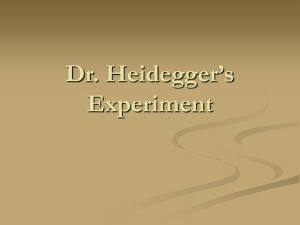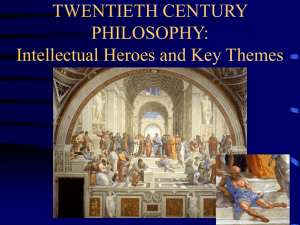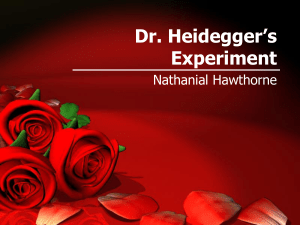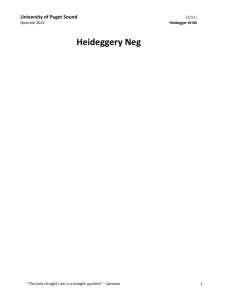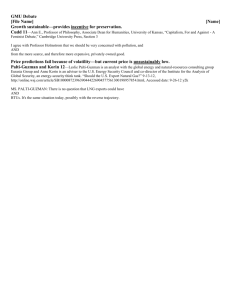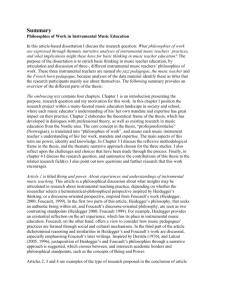What Heidegger Means by Being
advertisement
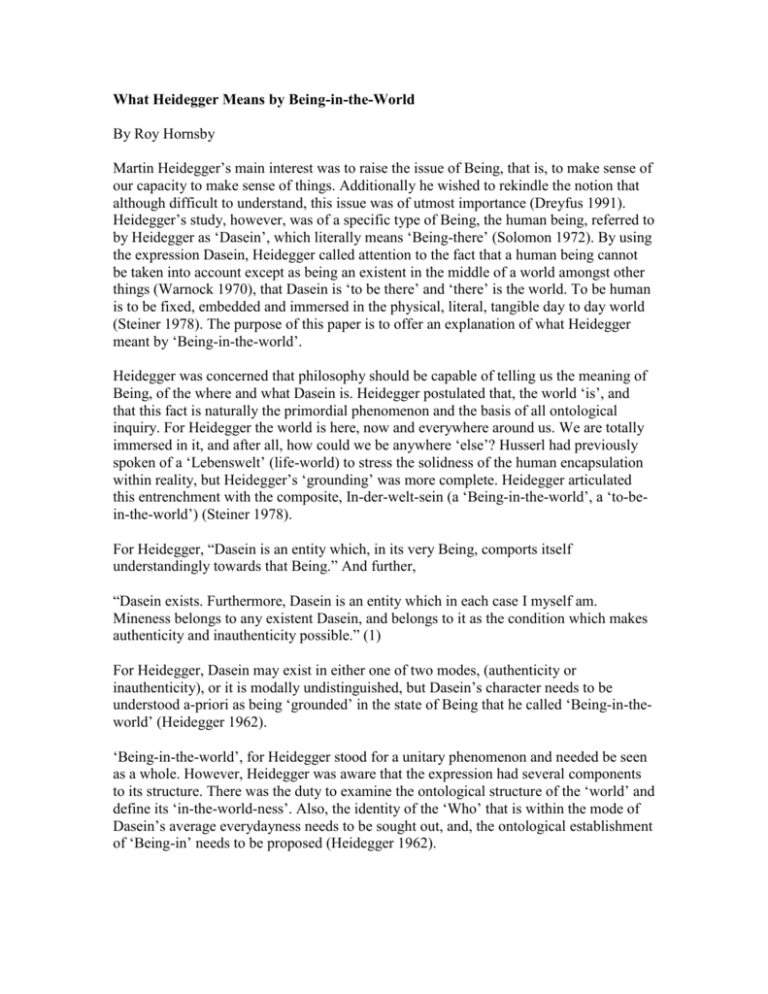
What Heidegger Means by Being-in-the-World By Roy Hornsby Martin Heidegger’s main interest was to raise the issue of Being, that is, to make sense of our capacity to make sense of things. Additionally he wished to rekindle the notion that although difficult to understand, this issue was of utmost importance (Dreyfus 1991). Heidegger’s study, however, was of a specific type of Being, the human being, referred to by Heidegger as ‘Dasein’, which literally means ‘Being-there’ (Solomon 1972). By using the expression Dasein, Heidegger called attention to the fact that a human being cannot be taken into account except as being an existent in the middle of a world amongst other things (Warnock 1970), that Dasein is ‘to be there’ and ‘there’ is the world. To be human is to be fixed, embedded and immersed in the physical, literal, tangible day to day world (Steiner 1978). The purpose of this paper is to offer an explanation of what Heidegger meant by ‘Being-in-the-world’. Heidegger was concerned that philosophy should be capable of telling us the meaning of Being, of the where and what Dasein is. Heidegger postulated that, the world ‘is’, and that this fact is naturally the primordial phenomenon and the basis of all ontological inquiry. For Heidegger the world is here, now and everywhere around us. We are totally immersed in it, and after all, how could we be anywhere ‘else’? Husserl had previously spoken of a ‘Lebenswelt’ (life-world) to stress the solidness of the human encapsulation within reality, but Heidegger’s ‘grounding’ was more complete. Heidegger articulated this entrenchment with the composite, In-der-welt-sein (a ‘Being-in-the-world’, a ‘to-bein-the-world’) (Steiner 1978). For Heidegger, “Dasein is an entity which, in its very Being, comports itself understandingly towards that Being.” And further, “Dasein exists. Furthermore, Dasein is an entity which in each case I myself am. Mineness belongs to any existent Dasein, and belongs to it as the condition which makes authenticity and inauthenticity possible.” (1) For Heidegger, Dasein may exist in either one of two modes, (authenticity or inauthenticity), or it is modally undistinguished, but Dasein’s character needs to be understood a-priori as being ‘grounded’ in the state of Being that he called ‘Being-in-theworld’ (Heidegger 1962). ‘Being-in-the-world’, for Heidegger stood for a unitary phenomenon and needed be seen as a whole. However, Heidegger was aware that the expression had several components to its structure. There was the duty to examine the ontological structure of the ‘world’ and define its ‘in-the-world-ness’. Also, the identity of the ‘Who’ that is within the mode of Dasein’s average everydayness needs to be sought out, and, the ontological establishment of ‘Being-in’ needs to be proposed (Heidegger 1962). Heidegger was concerned with Dasein’s distinctive method of being-in, which is at variance with the manner in which one object can be in another (Dreyfus 1991). In Being and Time Heidegger wrote: “What is meant by “Being-in”? Our proximal reaction is to round out this expression to “Being-in” ‘in the world’”, and we are inclined to understand this Being-in as ‘Being in something’ ….as the water is ‘in’ the glass, or the garment is ‘in’ the cupboard. By this ‘in’ we mean the relationship of Being which two entities extended ‘in’ space have to each other with regard to their location in that space…Being-present-at-hand-along-with in the sense of a definite location-relationship with something else which has the same kind of Being, are ontological characteristics which we call ‘categorical’ ” For Heidegger, these types of ‘categorical’ Beings belong to entities whose kind of Being is not Dasein. Heidegger continued that, on the other hand, Being-in is an existential state of Dasein’s Being and it cannot be thought of in terms of the Being-present-at-hand of a corporeal Thing ‘in’ an entity which is present at hand. Heidegger went on to say, “ ‘Being-in’ is thus the formal existential expression for the Being of Dasein, which has its Being-in-the-world as its essential state.” According to Steiner (1978), “Heidegger is saying that the notion of existential identity and that of world are completely wedded. To be at all is to be worldly. The everyday is the enveloping wholeness of being.” It is the convening of ‘Dasein’ and the ‘world’ which gives definition to both, and the solidness of these terms is covered thinly by the English word ‘facticity’ (Steiner 1978). Heidegger wrote; “Dasein’s facticity is such that its Being-in-the-world has always dispersed [zerstreut] or even split itself up into definite ways of Being-in. The multiplicity of these is indicated by the following examples: having to do with something, producing something, attending to something and looking after it, making use of something, giving something up and letting it go, undertaking, accomplishing, evincing, interrogating, considering, discussing, determining…. All these kind ways of Being-in have concern (‘Bersorgen’) as their kind of Being.” Heidegger (1962) used the term ‘concern’ as an ontological term for a possible way of Being-in-the-world because he felt that the Being of Dasein itself was to be revealed as ‘care’ (Sorge) and that because Being-in-the-world fundamentally belongs to Dasein, its Being concerning the world is fundamentally concern. Concern is the temporal meaning which Being-in-the-world has for human beings and it is the time configuration of human life which is the identical concern which human beings have for the world. If human beings had no concept of time they would have no reason to be engaged or implicated in the world in a human way. It is the awareness of temporality which establishes that the relationship that human beings have with the world is through concern (Warnock 1970). Not everything is possible for every human being. Every person’s options are limited in one way or another and ‘concern’ is a way that humans can decide what decision could be the correct one in order to move from one condition to another. Choices are made in the world in which humans exist surrounded by other humans. Human beings are characterized by uniqueness, one from another, and this uniqueness gives rise to a set of possibilities for each individual. All human beings are continually oriented towards their own potential, among which are the possibilities of authentic and inauthentic existence. If, whilst moving forward, the standards and beliefs and prejudices of societies are embraced, individuals may fail to differentiate themselves from the masses. This, Heidegger regarded as living an ‘inauthentic’ existence (Warnock 1970). For Heidegger, Authentic existence can only come into being when individuals arrive at the realization of who they are and grasp the fact that each human being is a distinctive entity. Once human beings realize that they have their own destiny to fulfill, then their concern with the world will no longer be the concern to do as the masses do, but can become an ‘authentic’ concern to fulfill their real potentiality in the world (Warnock 1970). Heidegger described the self of everyday Dasein as the ‘they-self’, “which we distinguish from the authentic Self – that is, from the Self which has been taken hold of in its own way [eigens ergriffenen]. As they-self, the particular Dasein has been dispersed into the ‘they’, and must first find itself.” And further “If Dasein discovers the world in its own way [eigens] and brings it close, if it discloses to itself its own authentic Being, then this discovery of the ‘world’ and this disclosure of Dasein are always accomplished as a clearing-away of concealments and obscurities, as a breaking up of the disguises with which Dasein bars its own way.” Heidegger (1962) said that deliberation on these matters have brought about a solid understanding of Dasein bringing the average everydayness of Being-in-the-world into view. Heidegger felt that the all-determining focal point of our Being-in-the-world was going unnoticed because the daily realities of our existence are so trite and numerous but, for Heidegger, ‘knowing’ was a kind of Being and Dasein only discovers itself when it comprehends reality. Knowledge is not an inexplicable bound from subject to object and return (Steiner 1978), “But no sooner was the ‘phenomenon of knowing the world’ grasped than it got interpreted in a ‘superficial’, formal manner. The evidence for this is the procedure (still customary today) of setting up knowing as a ‘relation between subject and Object’ – a procedure in which there lurks as much ‘truth’ as vacuity. But subject and Object do not coincide with Dasein and the world.” Heidegger (1962) said that a principle task was to reveal that knowing has a phenomenal character of a Being which is in and towards the world. Knowing is the possession of those human-Things which are able to know and is an internal characteristic of those entities. Heidegger expanded upon this by saying that knowing is a ‘concern’ and to know something, even with little interest, is a tangible kind of Being-in-the-world. In fact for Heidegger, even forgetting modifies the primordial Being-in and even as knowledge did not create the world nor forgetting, destroy it, it follows that Dasein only realizes itself when it grasps reality (Steiner 1978). Heidegger proclaimed that we are ‘thrown’ into the world and that our Being-in-theworld is a ‘thrownness’ [Geworfenheit]. To Heidegger this concept is a primordial banality which had long been overlooked by metaphysical conjecture. Humans beings are thrown with neither prior knowledge nor individual option into a world that was there before and will remain there after they are gone (Steiner 1978). Heidegger wrote; “This characteristic of Dasein’s Being – this ‘that it is’ – is veiled in its ‘whence’ and ‘whither’, yet disclosed in itself all the more unveiledly; we call it the ‘thrownness’ of this entity into its ‘there’; indeed, it is thrown in such a way that, as Being-in-the-world, it is the ‘there’. The expression ‘thrownness’ is meant to suggest the facticity of its being delivered over.” No biology of parentage can answer the question of whence we came into Being. Neither do we know toward what end our existence has been projected, apart from our position in relation to death. Yet for Heidegger, it is this twofold mystery that makes the ‘thrown’ state of human life the more absolute and tangible. Human kind is ‘delivered over’ to a total, all-encompassing ‘thereness’ and Dasein must occupy this presentness and take it up into its own existence. Heidegger wished to emphasize the unmistakable ‘thereness’ of the world into which we are thrown (Steiner 1978). The world into which our Dasein is thrown has others in it, and the existence of others is totally indispensable to its facticity of Being-there. Understanding of others in the world and the association of the ontological status of others with our own Dasein is, in itself, a form of Being. Heidegger said that Being-in-the-world is a being-with, and that the understanding of the presentness of others is to exist. However, being-with presents the possibility of comprehending our own Dasein as an everyday Being-with-one-another where we may come to exist not on our own terms, but only in reference to others. In so doing, we eventually come to not be ourselves, and surrender our existence to a formless ‘Theyness’ or alterity (Steiner 1978). For Heidegger, the ‘belonging to others’ is a drastic irresponsibility because the ‘they’ deprives the particular Dasein of its own accountability by making every decision and judgment for it. The ‘they’ can do this most easily because it can always be said that ‘they’ were responsible for such and such. Heidegger said that this passivity creates the alienated self, the ‘Man’ who is fatally disburdened of moral autonomy and, therefore, of moral responsibility. This ‘Man’ can know no ethical guilt. Heidegger called this the ‘self of everyday Dasein’ or the ‘they-self’, the total opposite of the solid singularity of a Dasein which has grasped itself. This crucial distinction was important for Heidegger as it is the distinction between an authentic and an inauthentic human existence (Steiner 1978). Inauthentic Dasein does not live as itself but as ‘they’ live. In fact, for Heidegger, it barely exists at all and it exists in a state of fear [Furcht](Steiner 1978). This fear is distinct from anxiety [Angst]. Fear could be experienced when a threat to our life, signifying our situation is recognised, but anxiety is experienced in the face of nothing in particular in our situation (Warnock 1970). According to Warnock (1970), anxiety is that which drives us to swamp ourselves in the insignificant, the common and in all of the elements of an inauthentic existence. However, Steiner (1978), wrote that fear is a part of a trite communal reaction whereas anxiety [Angst] is “that which makes problematic, which makes worthy of our questioning, our Being-inthe-world. Angst is one of the primary instruments through which the ontic character and context of everyday existence is made inescapably aware of, is rendered naked to, the pressures of the ontological. And further, Angst is a mark of authenticity, of the repudiation of the ‘theyness’.” Upon close investigation, Steiner’s interpretation is closer to Heidegger’s meaning surrounding Angst than is Warnock’s. Heidegger wrote that an understanding of Being belongs to the ontological structure of Dasein, and he proposed that there is an understanding state of mind in which Dasein is disclosed to itself. Heidegger sought a simplified way of disclosure to bring the structural totality of Being to light and he hypothesized that the state of mind that would satisfy his requirements, was the state of anxiety. Taking the phenomenon of falling as his departure point and distinguishing anxiety from fear, Heidegger wrote; “As one of Dasein’s possibilities of Being, anxiety – together with Dasein itself as disclosed in it – provides the phenomenal basis for explicitly grasping Dasein’s primordial totality of Being.” Steiner (1978) offers a demarcation in that, a further aspect of Dasein, as argued by Heidegger, is that Dasein is grounded in language; Being-in-the-world expresses itself in discourse. Furthermore, he made a distinction between ‘Rede’, ‘the speech of Dasein’ and ‘Gerede’, ‘talk’. He avoided the triteness of using the term ‘idle chatter’ for ‘talk’ because it was far too reassuring for what he wanted to say. For Heidegger, ‘talk’ had lost its primary relationship-of-being toward the talked about entity and all that ‘talk’ was doing was to ‘pass words along’ or, to ‘gossip emptily’, fostering illusions of understanding that have no real comprehension. Dasein-with-others takes place in an echo chamber of nonstop bogus interaction, with no cognition as to what is being communicated (Steiner 1978). The differences between authentic and inauthentic lives were contrasted by Heidegger through the agencies of fear set against anxiety, ‘speech’ contrasted with ‘talk’, genuine wonder opposed to mere novelty. Each disparate category comes about as an expected outcome of the complete antithesis between the self-possession of true Dasein and the collective lack of perception of an existence carried out in terms of ‘oneness’ and ‘theyness’. Heidegger denoted this latter state as ‘Verfall’ (‘a falling away from’ ‘a cadence into decline’). Heidegger was careful to point out that the condition of ‘Verfallensein’ (a fallen state) is not sinful, nor is the term meant to cast a moral value judgement. Heidegger wrote; “Dasein has, in the first instance, fallen away [abgefallen] from itself as an authentic potentiality for Being its self, and has fallen into the ‘world’. ‘Fallenness’ into the world means an absorption in Being-with-one-another, in so far as the latter is guided by idle talk, curiosity and ambiguity. Through the Interpretation of falling, what we have called the ‘inauthenticity’ of Dasein may now be defined more precisely. On no account however do the terms ‘inauthentic’ and ‘non-authentic’ signify ‘really not’, as if in this mode of Being, Dasein were altogether to lose its Being. ‘Inauthenticity’ does not mean anything like Being-no-longer-in-the-world, but amounts rather to quite a distinctive kind of Being-in-the-world – the kind which is completely fascinated by the ‘world’ and by the Dasein-with of Others in the ‘they’. Not-Being-its-self [Das Nicht-es-selbst-sein] functions as a positive possibility of that entity which, in its essential concern, is absorbed in a world. This kind of not-Being has to be conceived as that kind of Being which is closest to Dasein and in which Dasein maintains itself for the most part.” For Heidegger then, ‘inauthenticity’ and ‘fallenness’ are not mere mishaps or erroneous options. Rather they are essential components of existence, because Dasein is always Dasein-with and a Being-in-the-world into which we have been thrown. Acceding to the enticement of living a mundane existence is simply a part of existing itself. ‘Fallenness’ was a positive for Heidegger in the sense that there must be ‘inauthenticity’, ‘theyness’, and ‘talk’, for Dasein to become aware of its loss of self and strive for its return to authentic Being. ‘Verfall’ turns out to be the completely essential prerequisite towards the repossession of self, the struggle toward true Dasein (Steiner 1978). Dasein is committed to searching out the authentic via the inauthenticity of its Being-inthe-world and Heidegger said that authentic existence is not something which floats above everyday fallingness. He postulated that a proper instrument is needed for seizing the everydayness and he said that that instrument is ‘care’ [Sorge]. Because in the condition of inauthenticity we ‘fall away from ourselves’, Heidegger said that we simultaneously fall into a frenetic busyness and an emptiness that gives rise to a sense of the uncanny. As we flap about feeling ‘homeless’ our everyday familiarity is shattered (Steiner 1978). It is uncanniness that declares the pivotal moments in which Angst brings Dasein face to face with the terrible freedom of deciding whether to remain in inauthenticity or to endeavor to attain self-possession. ‘Sorge’ is the means of transcendence beyond being Dasein-with and Dasein-in to become Dasein-for and Sorge must be a ‘care for’ many things. These things include a concern for others, a care for the ready-to-hand, but in principle Sorge is a caring for the presentness and obscurity of Being itself (Steiner 1978). Heidegger said; “When Dasein ‘understands’ uncanniness in the everyday manner, it does so by turning away from it in falling; in this turning away, the ‘not-at-home’ gets ‘dimmed down’. Yet the everydayness of this fleeing shows phenomenally that anxiety, as a basic state of mind, belongs to Dasein’s essential state of Being-in-the-world, which, as one that is existential, is never present-at-hand but is itself always in a mode of factical Being-there – that is, in the mode of a state of mind.” For Heidegger, it is Sorge that signifies a mans existence and makes it meaningful. To be-in-the-world in an authentic existential pretext is to be ‘careful’. Heidegger concluded that ‘care’ is the primordial state of Being as Dasein strives towards authenticity (Steiner 1978). Finally, Heidegger said that Angst reveals to Dasein the opportunity of fulfilling itself in a fervent ‘freedom towards death’. This freedom has been released from the delusions of the ‘they’ to become accurate, certain of itself, and anxious. The temporality of Dasein is solidified by the awesome certainty that all Being is a Being-toward-death and that, “The ‘end’ of Being-in-the-world is death.” Heidegger wrote; “Death is a possibility-of-Being which Dasein itself has to take over in every case. With death, Dasein stands before itself in its ownmost potentiality-for-Being. This is a possibility in which the issue is nothing less than Dasein’s Being-in-the-world. Its death is the possibility of no-longer being-able-to-be-there. If Dasein stands before itself as this possibility, it has been fully assigned to its ownmost potentiality-for-Being. When it stands before itself in this way, all its relations to any other Dasein have been undone. This ownmost non-relational possibility is at the same time the uttermost one.” In the first division of “Being and Time”, Heidegger worked out his account of Being-inthe-world and used it to ground an insightful evaluation of long-established ontology and epistemology. For Heidegger, human beings are never directly in the world except by way of being in some particular circumstance; it is Dasein that is Being-in-the-world (Dreyfus 1991). References: Dreyfus, H. 1991, Being-in-the-World: A Commentary on Heidegger's Being and Time, Division I, The MIT Press, Cambridge. Heidegger, M. 1962, Being and Time, Harper & Row, New York. Solomon, R. 1972, From Rationalism to Existentialism: The Existentialists and Their Nineteenth Century Backgrounds, Harper & Row, New York. Steiner, G. 1978, Heidegger, The Harvester Press Limited, Sussex. Warnock, M. 1970, Existentialism, Oxford University Press, Oxford.
